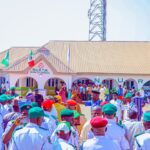Cunene, Angola – Two days after delivering her sixth child this August at Casa de Espera, a public health facility in Cunene, southern Angola, Victoria Luis was still so anxious that she couldn’t sit still or sleep properly.
The delivery had gone well. But the 32-year-old farmer, who walked 30km (19 miles) from her village of Tshiketiengue which has no hospital, could not wait to go back home to her five other children – the youngest only two years old.
Luis was worried that the children, who were being looked after by her neighbours, would have nothing to eat due to the latest episode of a recurrent drought that has affected southern Angola since 2012.
The below-average rainfalls, especially from 2018 to 2021, have triggered severe food shortages and deaths of livestock in parts of the region, especially the provinces of Cunene and Namibe. The United Nations says this is the worst climate crisis in 40 years in the Southern African country.
“Millions of people in southern Angola are facing an existential threat as drought aggravated by climate change continues to ravage the region,” Amnesty International said in a statement in July 2021. In 2022, the drought in southern Angola left an estimated 1.58 million people at risk of famine, according to the World Bank.
“This year, there was almost no rain, so we could not grow any product … during these last nine months, every day was a different one. I spent many days begging for food on the street,” Luis told Al Jazeera.
Neither she nor her partner have formal jobs, and their lives have always been dependent on agriculture. Their children, who used to take classes under trees because there was no proper school infrastructure nearby, can no longer attend them. Teachers, she says, have given up teaching in the region because they were often owed, and the lack of food and water meant that students would not attend classes regularly.

‘Between risk and despair’
Drought-related challenges such as hunger and wildfires also often make it difficult for some pregnant women to access hospitals in a country where traditional births are still favoured in some parts.
According to Doctors with Africa CUAMM, a health charity operating in Angola, there has been a significant drop in the number of deliveries performed at the Hospital da Missao Catolica do Chiulo, one of the biggest in Cunene, in recent years – from 1,891 in 2021 to 1,517 in 2022.
“Between risk and despair, many women still feel afraid of accessing hospitals but this will and must change,” says Germana Tuitileni, a traditional midwife for 20 years, who now gives talks to pregnant women on the importance of safer childbirth in hospitals.
The scarcity of food and water in the area has also been another incentive for pregnant women to make it past these challenges and head to Casa de Espera, now seen as the last resource in the region. So queues of expecting mothers waiting to be admitted are now common there.
“It was designed to receive only pregnant women with health issues and complications, so that they can be assisted before giving birth,” Wilca Ndapandula, the facility’s head, told Al Jazeera. “But with the climate crisis here, we see that many women only want to be admitted here because of the food assistance we provide.”
Some like Teofilia Lapitaco, 36, once used to deliver her babies at home in Outchitengato. For her fifth child, she walked more than 60km (37 miles) to get to the hospital.
“I came here because I heard that pregnant women were being fed. So I thought it was best to come because of my pregnancy, I wanted to be safer and assisted by a doctor,” she said. Lapitaco and her husband often go to Namibia, leaving their underage children with neighbours.
Local experts say while the drought has affected many people in rural areas, the effect has been more critical for women.
“With the drought, women face many challenges as they are expected to provide for their children,” Alice Peso, manager of Action for Rural Development and Environment (ADRA) non-governmental organisation in Cunene. “Thus, a lot of them, sometimes even pregnant, are forced to go to neighbouring Namibia to do domestic work and be able to obtain some financial resources.”
In the few water fountains in southern Angola, it is mostly women and children digging for water used by the entire community.
“There are pregnant women who have to travel long distances to find water. Here, this is a woman’s job, regardless of them being pregnant or not,” says Paola Caravoggi, an Italian doctor on a humanitarian mission in the region.
Luis corroborates this: in her most recent pregnancy, she “had to walk countless kilometres to look for a mouthful of water” to take home to her family, she said. Her husband declined to help with the chore, saying it was a woman’s job.
The water she talks about is from a chimpaca, a small pond that they share with roaming cattle and use for everything from drinking to washing clothes.
A dire situation
ADRA’s Peso said many expectant and nursing mothers even struggle to deal with their daily hygiene – and that of the newborns – simply because there is no clean water.
“There is a dire economic vulnerability within these families. In rural areas, there is almost no buying power. Many of these women only eat once a day simply because they cannot afford to eat more,” Peso says.
Ndapandula also told Al Jazeera that most of the women they admit are used to drinking dirty water. The practice has gone on for so long that sometimes it does not even cause them any health issues any more. “It’s like their bodies have become used to it,” she added.
Al Jazeera spoke to 11 pregnant women in the region who said they often feel a lot of pain whenever they return home after hours of walking in search of water and food.
In 2022, Canal do Cafu, a water distribution channel built by the government for $137m, opened in Cunene to provide water to the population and boost the region’s agriculture. But many local activists say the ambitious initiative seems not to have worked.
Canal do Cafu is seen as being too far away from the most drought-affected regions, making it hard for people to reach it.
Peso says the government needs to take a more active and realistic approach instead to support the most vulnerable people in Cunene.
“We need more realistic public policies,” she said. “The government needs to create a contingency plan to tackle the impacts of the drought on people’s lives here in Cunene.”
The ministries of environment and family declined to comment.
The women at the heart of the crisis say they have no idea when things will change for the better for them and their children being born into the situation.
“It feels like our suffering will have no end,” Luis told Al Jazeera, almost shedding tears.
Source : Al Jazeera
















